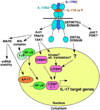Structure-function relationships in the IL-17 receptor: implications for signal transduction and therapy
- PMID: 18178098
- PMCID: PMC2667118
- DOI: 10.1016/j.cyto.2007.11.013
Structure-function relationships in the IL-17 receptor: implications for signal transduction and therapy
Abstract
IL-17 is the defining cytokine of a newly-described "Th17" population that plays critical roles in mediating inflammation and autoimmunity. The IL-17/IL-17 receptor superfamily is the most recent class of cytokines and receptors to be described, and until recently very little was known about its function or molecular biology. However, in the last year important new insights into the composition and dynamics of the receptor complex and mechanisms of downstream signal transduction have been made, which will be reviewed here.
Figures



References
-
- Ozaki K, Leonard WJ. Cytokine and cytokine receptor pleiotropy and redundancy. J Biol Chem. 2002;277:29355–29358. - PubMed
-
- Aggarwal S, Gurney AL. IL-17: A prototype member of an emerging family. J. Leukoc. Biol. 2002;71:1–8. - PubMed
-
- Moseley TA, Haudenschild DR, Rose L, Reddi AH. Interleukin-17 family and IL-17 receptors. Cytokine Growth Factor Rev. 2003;14:155–174. - PubMed
-
- Fossiez F, Djossou O, Chomarat P, Flores-Romo L, Ait-Yahia S, Maat C, Pin J-J, Garrone P, Garcia E, Saeland S, Blanchard D, Gaillard C, Das Mahapatra B, Rouvier E, Golstein P, Banchereau J, Lebecque S. T cell interleukin-17 induces stromal cells to produce proinflammatory and hematopoietic cytokines. J. Exp. Med. 1996;183:2593–2603. - PMC - PubMed
Publication types
MeSH terms
Substances
Grants and funding
LinkOut - more resources
Full Text Sources
Other Literature Sources

